An online project under the direction of the CAPE ANN MUSEUM
inv. 49
The "Britannia" Entering Boston Harbor
1848 Oil on panel 14 3/4 x 19 3/4 in. (37.5 x 50.2 cm) Initialed lower left: FHL
|
Related Work in the Catalog
Supplementary Images
Explore catalog entries by keywords view all keywords »
Historical Materials
Below is historical information related to the Lane work above. To see complete information on a subject on the Historical Materials page, click on the subject name (in bold and underlined).
Samuel Cunard founded the Cunard Line in 1840. Four new liners were commissioned, to be launched on February 5. The first of the new class was called "Britannia"; three sisters of "Britannia" were "Acadia," "Caledonia," and "Columbia." The "Britannia" was a side-wheel steamship with a barkentine rig (square-rigged on the foremast; fore-and-aft rigged on the main and mizzen masts). She also had an orange-red straight funnel, and luxurious interiors.The sails were for steadying her motion in heavy seas, maintaining headway, and staying on course if the engines broke down.
The liner operated on a regular schedule. She was built on the Clyde in Glasgow and arrived in Liverpool in June 1840. She departed on July 4 and arrived in Boston July 17. She was berthed at the specifically designed "Cunard Wharf" to great excitement in Boston. Charles Dickens, his wife Kate, and their maid were passengers for the crossing in January 1842. In January 1844, Boston Harbour froze and trapped the ship as she was about to leave for Liverpool. A seven-mile channel was created to free her so that she could keep to her schedule. Her final crossing was in 1848, when she was sold to the German navy.
"Britannia" statistics: 207 feet long; 1,139 tons; 9 knot service speed; 115 passengers.
Royal Museums, Greenwich
Speech presenting the silver wine service to Captain John Hewitt by the passengers after the safe arrival of the steamship "Britannia" in Boston.
overall: 190 x 110 mm
National Maritime Museum, Greenwich
PLT 0200, 0201, 0202, 0203
One of a pair of American silver goblets presented to Captain John C. Hewitt by the passengers of the "Britannia" steamship.
A four-piece wine set with its original wooden carrying case presented to Captain John C. Hewitt by the passengers of the 'Britannia' steamship, 1842. The goblet is on a foliate-chased rising circular base, with a balaster stem and moulded rim, the bowl chased with rising acanthus leaves. It is inscribed: "Presented to Capt. John Hewett [sic] of the Britannia Steamship by the passengers, January 1842"; the base has a wooden inset covered in red baize. The wine set was presented to Captain Hewitt on January 29, 1842 in the Tremont Theatre, Boston. Charles Dickens wrote an account of his stormy transatlantic crossing on board the "Britannia" in the second chapter of American Notes (1842).
17 1/4 x 24 7/8 in.
American Antiquarian Society, Worcester, Mass.
Also filed under: Boston Harbor » // Bouvé & Sharp, Lith. – Boston » // De Vaudricourt, Augustus » // Sharp's, J. C., Lith. – Boston »
5.6.1841
Newspaper
p. 2 col. 1
"Arrival of the Britannia.
12 days later from England.
Highly Important from China: Great Fall in the Price of Teas: Great Excitement in Relation to the Non-Arrival of the Steamer President.
The Royal Mail steamship Britannia, Capt R. B. Cleland, arrived at this port this morning, at 2' clock, from Liverpool, having left on the 20th ult. at 12 M. She ran 200 miles to the south of her course, to avoid the ice, which lengthened her passage. Arrived at Halifax on Tuesday morning, and left at 1 P.M., making her passage to Boston in 38 hours. She had 87 passengers to Halifax, landed 56, and took in 9 additional for Boston."
Also filed under: Cleland, Captain Richard » // Newspaper / Journal Articles »
Newspaper
p.3
"...On the 25th, 26th, and 27th, the Britannia experienced very severe gales, and on Sunday the 26th she shipped a sea which stove the bulwarks on the larboard bow, and broke the leg of one of the crew..."
Also filed under: Newspaper / Journal Articles »
Newspaper
col.1
"The Britannia arrived out on the 29th... the fastest passage ever made..."
Also filed under: Newspaper / Journal Articles »
Newspaper
p. 2 col. 2
"There is a beautiful painting exhibiting at the window of W. H. Oakes's music store, No. 13 Tremont Row. It represents the steamship Britannia during the most terrific gale she ever encountered. It was on the morning of the 23d of April last, on her passage from Liverpool to this port. The picture was painted expressly for Capt. Cleland, by Mr F.H. Lane, one of the best painters of sea views in the country."
"Vesting and Pantaloon Stuffs Per Steamer Britannia"
Also filed under: Newspaper / Journal Articles »
"It is the third morning. I am awakened out of my sleep by a dismal shriek from my wife who demands to know whether there's any danger. I rouse myself and look out of bed. The water jug is plunging and leaping like a lively dolphin; all the smaller articles are afloat except my shoes which are stranded on a carpet bag high and dry, like a couple of coal barges. Suddenly I behold them spring into the air and see the looking glass, which is nailed to the wall, sticking fast upon the ceiling. At the same time the door entirely disappears and a new one is opened in the floor. Then I begin to comprehend that the state room is standing on its head.
Before it is possible to make any arrangement at all compatible with this novel state of things, the ship rights. Before one can say: 'Thank Heaven!' she wrongs again. Before one can cry: 'She is wrong' she seems to have started forward and to be a creature actively running of its own accord, with broken knees and failing legs, through every variety of hole and pitfall, and stumbling constantly. Before one can so much as wonder, she takes a high leap into the air. Before she has well done that, she takes a deep dive into the water. Before she has gained the surface, she throws a somerset. The instant she is on her legs, she rushes backward. And so she goes on, staggering, heaving, wrestling, leaping, diving, jumping, pitching, throbbing, rolling and rocking, and going through all these movements sometimes by turns and sometimes all together until one feels disposed to roar for mercy."
Also filed under: Chronology » // Letters »
lithograph
15 x 25 in (38.1 x 63.5 cm)
Peabody Essex Museum
Also filed under: Bouvé & Sharp, Lith. – Boston »
Pottery
9 in (22.86 cm)
M3233
Peabody Essex Museum
This China was issued to celebrate the establishment of the British and North American Royal Mail Steam Packet Company, which later became Cunard. Some might have been used on board Britannia and the other three ships depicted.
Ship model
50'/1"
M15732
Peabody Essex Museum
Also filed under: Objects »
Library of Congress Catalog Number 2004671768
Also filed under: Boston Harbor »
Robert Bennet Forbes scrapbook
vol. 1, p. 4
Phillips Library, Peabody Essex Museum (SCR 4)
"SPLENDID NAVAL VICTORY. We have received intelligence by the arrival of the Caledonia of one of the most splendid naval victories ever achieved under the American flag..." This article is a humorous metaphor, comparing Forbes' mission to bring food to the starving Irish to a naval assault on the city of Cork.
Also filed under: "Jamestown" (U.S. Sloop of War) » // Forbes, Robert Bennet » // Newspaper / Journal Articles »
In the ninteenth century, the term "bark" was applied to a large sailing vessel having three masts, the first two (fore and main) being square-rigged; the third (mizzen), fore-and-aft rigged. The reduced square-rig made the vessel easier and more economical to handle, using a smaller crew. (1)
Barks had significant presence in mid-nineteenth-century America, as indicated by Lane’s depictions of them. Hardly any are to be found in his scenes of major ports, but some do appear in his Cape Ann scenes (see The Fort and Ten Pound Island, Gloucester (Harbor Scene), 1848 (inv. 58), View of Gloucester, 1859 (inv. 91), Gloucester Harbor, 1850s (inv. 391), and Bark "Eastern Star" of Boston, 1853 (inv. 571)), also in views of other small ports and of coastal shipping (see Clipper Ship "Southern Cross" in Boston Harbor, 1851 (inv. 253), Merchantmen Off Boston Harbor, 1853 (inv. 267), Approaching Storm, Owl's Head, 1860 (inv. 399), and Bark "Mary" (inv. 629)).
Brigs, and to a lesser extent ships, were the vessels of choice for Gloucester’s foreign trade in the first half of the nineteenth century. They brought cargos from the West Indies, South America, and Europe, anchoring in the deeper parts of the Inner Harbor while lighters off-loaded the goods and landed them at the wharves in Harbor Cove, by then too shallow for the newer, larger merchant vessels coming into use. (2) By mid-century, barks were gradually replacing brigs and ships, while the trade with Surinam was removed to Boston in 1860. (3)
Some bulk cargos still had to be landed in Gloucester, salt for curing fish being the most important. “Salt barks” brought Tortugas salt from the West Indies, and in the 1870s, Italian salt barks began bringing Trapani salt from Sicily. The importation of salt by sailing ships ended with the outbreak of World War I. (4)
The term barkentine, like the bark, pre-dates the nineteenth century, but in the mid- to late 1800s referred to a large vessel of three masts (or more), with only the fore mast square-rigged, the others being fore-and-aft-rigged. In Lane’s time, the term was little known in the United States, while many other names were coined for the rig. One of these early terms was demi-bark, probably from the French demi-barque, which was applied to a very different kind of vessel. (5) Lane’s depictions of these rigs include a lithograph of the steam demi-bark "Antelope" View of Newburyport, (From Salisbury), 1845 (inv. 499) and at least three depictions of Cunard steamships The "Britannia" Entering Boston Harbor, 1848 (inv. 49), Cunard Steamship Entering Boston Harbor (inv. 197), and Cunard Liner "Britannia", 1842 (inv. 259). (6) None of these subjects typify the barkentine rig as applied to sails-only rigs as they developed in the years after Lane’s death.
– Erik Ronnberg (May, 2015)
References:
1. R[ichard] H[enry] Dana, Jr., The Seaman's Friend (Boston; Thomas Groom & Co., 1841. 13th ed., 1873), 97 and Plate IV with captions; and M.H. Parry, et al., Aak to Zumbra: A Dictionary of the World's Watercraft (Newport News, VA: The Mariners’ Museum, 2000), 43.
2. Alfred Mansfield Brooks, Gloucester Recollected (Gloucester, MA: Peter Smith, 1974), 56, note 10; 67, note 7.
3. James R. Pringle, History of the Town and City of Gloucester (1892. Reprint: Gloucester, MA, 1997), 106–08.
4. Raymond McFarland, A History of the New England Fisheries (Philadelphia: University of Pennsylvania, 1911), 95–96; and Mark Kurlansky, Salt: A World History (New York: Walker & Co., 2002), 419–420.
5. Parry, 44, 167. Dana has neither definition nor illustration of this rig.
6. J[ohn] W. Griffiths, “The Japan and China Propeller Antelope," U.S. Nautical Magazine III (October 1855): 11–17. This article includes an impression of Lane’s lithograph on folded tissue.
Stereograph card
Cape Ann Museum Library & Archive
This view of Gloucester's Inner Harbor shows three square-rigged vessels in the salt trade at anchor. The one at left is a (full-rigged) ship; the other two are barks. By the nature of their cargos, they were known as "salt ships" and "salt barks" respectively. Due to their draft (too deep to unload at wharfside) they were partially unloaded at anchor by "lighters" before being brought to the wharves for final unloading.
– Erik Ronnberg
Also filed under: Historic Photographs » // Salt » // Waterfront, Gloucester »
Schooners in Lane’s time were, with few exceptions, two-masted vessels carrying a fore-and-aft rig having one or two jibs, a fore staysail, gaff-rigged fore- and main sails, and often fore- and main topsails. One variant was the topsail schooner, which set a square topsail on the fore topmast. The hulls of both types were basically similar, their rigs having been chosen for sailing close to the wind. This was an advantage in the coastal trade, where entering confined ports required sailing into the wind and frequent tacking. The square topsail proved useful on longer coastwise voyages, the topsail providing a steadier motion in offshore swells, reducing wear and tear on canvas from the slatting of the fore-and-aft sails. (1)
Schooners of the types portrayed by Lane varied in size from 70 to 100 feet on deck. Their weight was never determined, and the term “tonnage” was a figure derived from a formula which assigned an approximation of hull volume for purposes of imposing duties (port taxes) on cargoes and other official levies. (2)
Crews of smaller schooners numbered three or four men. Larger schooners might carry four to six if a lengthy voyage was planned. The relative simplicity of the rig made sail handling much easier than on a square-rigged vessel. Schooner captains often owned shares in their vessels, but most schooners were majority-owned by land-based firms or by individuals who had the time and business connections to manage the tasks of acquiring and distributing the goods to be carried. (3)
Many schooners were informally “classified” by the nature of their work or the cargoes they carried, the terminology coined by their owners, agents, and crews—even sometimes by casual bystanders. In Lane’s lifetime, the following terms were commonly used for the schooner types he portrayed:
Coasting schooners: This is the most general term, applied to any merchant schooner carrying cargo from one coastal port to another along the United States coast (see Bar Island and Mt. Desert Mountains from Somes Settlement, 1850 (inv. 401), right foreground). (4)
Packet schooners: Like packet sloops, these vessels carried passengers and various higher-value goods to and from specific ports on regular schedules. They were generally better-maintained and finished than schooners carrying bulk cargoes (see The Old Fort and Ten Pound Island, Gloucester, 1850s (inv. 30), center; and Gloucester Inner Harbor, 1850 (inv. 240), stern view). (5)
Lumber schooners: Built for the most common specialized trade of Lane’s time, they were fitted with bow ports for loading lumber in their holds (see View of Southwest Harbor, Maine: Entrance to Somes Sound, 1852 (inv. 260)) and carried large deck loads as well (Stage Rocks and the Western Shore of Gloucester Outer Harbor, 1857 (inv. 8), right). Lumber schooners intended for long coastal trips were often rigged with square topsails on their fore masts (see Becalmed Off Halfway Rock, 1860 (inv. 344), left; Maverick House, 1835 (not published); and Lumber Schooner in a Gale, 1863 (inv. 552)). (6)
Schooners in other specialized trades. Some coasting schooners built for carrying varied cargoes would be used for, or converted to, special trades. This was true in the stone trade where stone schooners (like stone sloops) would be adapted for carrying stone from quarries to a coastal destination. A Lane depiction of a stone schooner is yet to be found. Marsh hay was a priority cargo for gundalows operating around salt marshes, and it is likely that some coasting schooners made a specialty of transporting this necessity for horses to urban ports which relied heavily on horses for transportation needs. Lane depicted at least two examples of hay schooners (see Gloucester Harbor, 1850s (inv. 391), left; and Coasting Schooner off Boon Island, c.1850 (inv. 564)), their decks neatly piled high with bales of hay, well secured with rope and tarpaulins.
– Erik Ronnberg
References:
1. Howard I. Chapelle, The History of American Sailing Ships (New York: W.W. Norton & Co., 1935), 258. While three-masted schooners were in use in Lane’s time, none have appeared in his surviving work; and Charles S. Morgan, “New England Coasting Schooners”, The American Neptune 23, no. 1 (DATE): 5–9, from an article which deals mostly with later and larger schooner types.
2. John Lyman, “Register Tonnage and its Measurement”, The American Neptune V, nos. 3–4 (DATE). American tonnage laws in force in Lane’s lifetime are discussed in no. 3, pp. 226–27 and no. 4, p. 322.
3. Ship Registers of the District of Gloucester, Massachusetts, 1789–1875 (Salem, MA: The Essex Institute, 1944). Vessels whose shipping or fishing voyages included visits to foreign ports were required to register with the Federal Customs agent at their home port. While the vessel’s trade or work was unrecorded, their owners and master were listed, in addition to registry dimensions and place where built. Records kept by the National Archives can be consulted for information on specific voyages and ports visited.
4. Howard I. Chapelle, The National Watercraft Collection (Washington, DC: Smithsonian Institution, 1960), 40, 42–43.
5. Ibid., 42–43, 73.
6. Ibid., 74–76.
A topsail schooner has no tops at her foremast, and is fore-and-aft rigged at her mainmast. She differs from an hermaphrodite brig in that she is not properly square-rigged at her foremast, having no top, and carrying a fore-and-aft foresail instead of a square foresail and a spencer.
Wood rails, metal rollers, chain; wood cradle. Scale: ½" = 1' (1:24)
Original diorama components made, 1892; replacements made, 1993.
Cape Ann Museum, from Gloucester Chamber of Commerce, 1925 (2014.071)
A schooner is shown hauled out on a cradle which travels over racks of rollers on a wood and metal track.
Also filed under: Burnham Brothers Marine Railway » // Marine Railways »
Glass plate negative
Collection of Erik Ronnberg
Also filed under: Lobstering »
Details about Maine's lumber trade in 1855, see pp. 250–52
Also filed under: Castine » // Lumber Industry »
"Engine-powered vessel" is a collective term used by nautical historians to include all vessel types using engine power of any type for propulsion, whether assisted by sails, oars, or other motive power. In Lane's time, steam reciprocating engines fueled by wood or coal were the only practical source of this power for ships using paddle-wheels or screw propellers to convert heat energy into motion.
For most of the nineteenth century, steamships had sails for auxiliary power; indeed the earliest examples relied principally on sails, using engine power in calm weather to shorten the voyage time or keep to a schedule. As engines became more efficient, powerful, and reliable, sail plans were reduced, to be used only to steady a vessel's motion in a seaway (for the sake of seasick passengers), or to maintain headway if the engine broke down. Only harbor craft, ferry boats, and coastwise passenger steamers relied solely on engine power.
Among Lane's depictions of steamships, the auxiliary steam packet Auxiliary Steam Packet Ship Massachusetts (inv. 442) is a good example of primary reliance on sails, while the steam demi-bark The "Britannia" Entering Boston Harbor, 1848 (inv. 49) and the Cunard Liner "Britannia", 1842 (inv. 259) have relegated sails to secondary (or simply emergency) motive power.
– Erik Ronnberg
Castine Historical Society Collections (2015.03)
Also filed under: Historic Photographs » // Steamers »
Published by James French, Boston
Volume 1848-49
Boston Public Library
Call number 39999059856813
See p. 30 of directory.
Also filed under: "Britannia" (Cunard Steamship) » // "Caledonia" (Cunard Steamship) » // Trade Routes and Statistics »
Cartoon
9 1/4 x 13 3/4 in (23.495 x 34.925 cm)
Peabody Essex Museum, Salem, Mass.
Jonny and a Yankee:
Jonny: "Ho my Hi! 'ow she goes!! it his'nt fair I ham sure t'aint!!! She must 'av an engine hunder the keel..."
Yankee: "Where are your yachts now, Jonny? s-a-y- Do you think your wash tubs can come up to a real Yankee Clipper? Sorry for you, Jonny, but it can't be helped... A Yankee Ship a Yankee Crew, you know Jonny."
Also filed under: "America" (Schooner Yacht) »
Lithograph
Library of Congress Catalog Number 2002706878
Design of side wheel steamer showing wheel mechanism, side view and cross-section in ten figures. This design proved a failure in the few vessels that employed it. The paddle wheel enclosures filled with water, causing resistance which greatly impaired efficiency and increased fuel consumption.
– Erik Ronnberg
Oil on canvas
Maine Maritime Museum
Also filed under: Castine »
Steamer schedules for 1855, including the schedule for the steamer, "T. F. Secor" which served Castine, see pp. 234–35.
Also filed under: "T. F. Secor" (Steamboat) » // Castine » // Publications » // Steamers »
The Whitehall Boat, like the yawl boat, is an early nineteenth-century refinement of an earlier ship's boat type—very likely the gigs of warships. Builders of the earliest examples are believed to have been former navy shipyard employees whose knowledge was put to use building similar boats in their shops on Whitehall Street in lower Manhattan. Recognized as a distinct small boat type in the 1830s, by mid-nineteenth century the Whitehall Boat was in use in most American seaports. (1)
Lane depicted Whitehall Boats in a number of his paintings of major ports, including New York Harbor, c.1855 (inv. 46) (right center foreground), which shows a large example, rowed by four men witha single passenger in the stern, illustrating one of its chief uses as a water taxi. These craft were also used by ship chandlers to deliver ship supplies, and most notoriously by "crimps" who used them to deliver drunken seamen to outbound ships needing crews. Not intended for use in open sea, their light yet strong construction, fine lines, and maneuverability made them ideal for in-harbor work. (2)
Other Whitehall boats appear in the foregrounds of Boston and other unidentified major port scenes (see New England Harbor at Sunrise, c.1850 (inv. 27), Brig "Antelope" in Boston Harbor, 1863 (inv. 43), The "Britannia" Entering Boston Harbor, 1848 (inv. 49), Boston Harbor, Sunset, 1850–55 (inv. 242), The "Constitution" in Boston Harbor, c.1848–49 (inv. 243), and Clipper Ship "Southern Cross" in Boston Harbor, 1851 (inv. 253)).
References:
1. Howard I. Chapelle, American Small Sailing Craft (New York: W.W. Norton & Co., 1951), 195–96.
2. Ibid., 196–99.
Oil on canvas
36 x 60 1/4 in.
Museum of Fine Arts, Boston, Gift of Maxim Karolik for the M. and M. Karolik Collection of American Paintings, 1815–65 (48.446)
Detail of Whitehall boat.
Also filed under: New York Harbor »
The ensign of the United States refers to the flag of the United States when used as a maritime flag to indentify nationality. As required on entering port, a vessel would fly her own ensign at the stern, but a conventional token of respect to the host country would be to fly the flag of the host country (the United States in Boston Harbor, for example) at the foremast. See The "Britannia" Entering Boston Harbor, 1848 (inv. 49) for an example of a ship doing this. The American ensign often had the stars in the canton arranged in a circle with one large star in the center; an alternative on merchant ensigns was star-shaped constellation. In times of distress a ship would fly the ensign upside down, as can be seen in Wreck of the Roma, 1846 (inv. 250).
The use of flags on vessels is different from the use of flags on land. The importance and history of the flagpole in Fresh Water Cove in Gloucester is still being studied.
The modern meaning of the flag was forged in December 1860, when Major Robert Anderson moved the U.S. garrison from Fort Moultrie to Fort Sumter in Charleston Harbor. Adam Goodheart argues this was the opening move of the American Civil War, and the flag was used throughout northern states to symbolize American nationalism and rejection of secessionism.
Before that day, the flag had served mostly as a military ensign or a convenient marking of American territory, flown from forts, embassies, and ships, and displayed on special occasions like American Independence day. But in the weeks after Major Anderson's surprising stand, it became something different. Suddenly the Stars and Stripes flew—as it does today, and especially as it did after the September 11 attacks in 2001—from houses, from storefronts, from churches; above the village greens and college quads. For the first time American flags were mass-produced rather than individually stitched and even so, manufacturers could not keep up with demand. As the long winter of 1861 turned into spring, that old flag meant something new. The abstraction of the Union cause was transfigured into a physical thing: strips of cloth that millions of people would fight for, and many thousands die for.
– Adam Goodheart, Prologue of 1861: The Civil War Awakening (2011).
Stereograph card
Cape Ann Museum Library & Archive
A view of a Cove on the western side of Gloucester Harbor, with the landing at Brookbank. Houses are seen in the woods back. A boat with two men is in the foreground.
Also filed under: Brookbank » // Fresh Water Cove » // Historic Photographs »
Courtesy American Antiquarian Society, Worcester, Mass. (CL.F9116.011.1854 CL.F9116.011.1854)
Also filed under: Oak Hall »
Courtesy American Antiquarian Society, Worcester, Mass. (CL.F9116.011.1854)
Also filed under: Oak Hall »
The use of signal flags, for ship-to-ship communication, generally preceded land-based chains of maritime semaphore stations, the latter using flags or rotating arms, until the advent of the electric or magnetic telegraph.
Until the end of the Napoleonic wars, merchant ships generally sailed in convoy as ordered by the escorting warship(s) using a few simple flags. Peace brought independent voyaging, the end of the convoy system, and the realization by various authorities that merchant vessels now needed their own separate means of signaling to each other. This resulted in a handful of rival codes, each with its individual flags and syntax. In general, they each had a section enabling ship identification and also a "vocabulary" section for transmitting selected messages. It was not until 1857 that a common Commercial Code became available for international use, only gradually replacing the earlier ones. All existed side by side for a decade or two.
Signal systems for American ships were originally intended to identify a vessel by name and owner; only later were more advanced systems developed to convey messages. Most basic were private signals, or "house flags", each of a different design or pattern, identifying the vessel's owner; identification charts were local and poorly distributed, limiting their usefulness. A secondary signal, a flag or large pennant bearing the vessel's name, was sometimes flown by larger ships, but pictorial records of them are uncommon. These private signal flags usually flew from the foremasthead or main masthead if a three master ship. Pilot boats had their own identifying flags, blue and white as seen in Spitfire Entering Boston Harbor (inv. 536). Small vessels, such as schooners, often had a "tell-tale" pennant, an often-unmarked and often red flag, that was used to determine wind direction.
A numerical code flag system, identifying vessels by the code numbers, was introduced by Captain Frederick Marryat R.N. in 1817 for English vessels. American vessels soon adopted this system. Elford's "marine telegraphic system" was the first American equivalent to the Marryat code flags, first issued in 1823, and with changes, remaining in use until the late 1850s. Most of the signal flags on vessels depicted by Lane use Elford's; Brig "Antelope" in Boston Harbor, 1863 (inv. 43) is a noteworthy example of his depiction of Marryat's. The Elford's Code was popular in America on account of its simplicity and only required six blue and white flags. Eventually these changed to red and white, although it is unclear exactly when this happened. Instructions and a key ot the Elford's Code's use are included in successive editions of the Boston Harbor Signal Book.
Whereas the other codes employ at least ten flags of diverse shapes and colours, there are only six Elford flags in total, representing the numbers one to six. All are uniformly rectangular and monochrome in colour (either blue and white or red and white—or even black and white as in an early photograph). Selected from these six flags each individual vessel is allotted a combination of four flags to be prominently displayed as a vertical hoist. Reading from above down these convey its "designated number." Armed with this number and the type of vessel (e.g. ship, bark, brig, schooner /or steamer) the subject can be uniquely identified by reference to a copy of the Boston Harbor Signal Book for the appropriate year.
– A. Sam Davidson
As reproduced in Yankee Sailing Ship Cards by Allan Forbes and Ralph M. Eastman (Boston: State Street Trust Company, 1948).
Also filed under: "Eastern Star" (Bark) » // Forbes, Robert Bennet »
Harvard Depository: Widener (NAV 578.57)
For digitized version, click here.
Also filed under: Boston Harbor »
Boston: Eastburn's Press
New York Public Library
Complete book is included in Google Books, click here.
In The American Neptune 3, no. 3 (July 1943): 205–21.
Peabody Essex Museum
Descriptions of Marryat, Elford, Rogers, and commercial code signal systems, and private signals. Includes illustrations of flag systems with color keys.
Vessel ornamentation assumed two forms: carvings and color schemes. Carvings, or "ship carvings," as they are called by maritime scholars, are usually crafted in wood and painted or gilt. Many vessels were too small or their owners too frugal to permit carved embellishments, in which cases the enhancement of the vessel's color scheme was a practical alternative. This can be seen in many of the coastal vessels along the new England coast. Pinkies and Chebacco boats had handsome color schemes using only black and green with white sheer lines and limited use of red and yellow. Other combinations of inexpensive pigments were used to improve the simple looks of sloops and schooners in the packet trade, while small pleasure craft and pilot schooners enhanced their appearance in similar ways. Clipper ship owners, finding their vessels' appearance impressive without adding color, settled for unrelieved black hulls. Naval vessels as well preserved their formidable looks with black, relieved only with a white belt in way of the gunports.
The more elaborate ship carvings can be classified in the following categories:
Billetheads: mounted on the bow, at the end of a simple gammon knee, or on the forward end of an elaborate stem-head, they can be scrolls of less or greater intricacy, or sometimes the heads of animals, eagles being the most common. Examples of a sea serpent's head, a pointing hand, and other animal heads have been found. (See Brig "Cadet" in Gloucester Harbor, late 1840s (inv. 13); Brig "Antelope" in Boston Harbor, 1863 (inv. 43); and Brig Off the Maine Coast, 1851 (inv. 241))
Figureheads: mounted on bows of larger vessels, often with elaborate stem joinerwork (trailboards and headboards with associated knees and rails). Usually these were full-length figures representing the ship's owner, a famous citizen, a mythological person or animal, or an eagle. (See Portrait of the "National Eagle", 1853 (inv. 35) (eagle); New York Harbor, c.1855 (inv. 46); The "Britannia" Entering Boston Harbor, 1848 (inv. 49) (female figures); The Ships "Winged Arrow" and "Southern Cross" in Boston Harbor, 1853 (inv. 54) (dragon and eagle); "Starlight" in Harbor, c.1855 (inv. 249) (dragon); and Steam demi bark Antelope, 615 tons, c.1855 (inv. 375) (antelope))
Trailboards: carved vines or scrollwork abaft the figurehead which trail aft along the stem head in a graceful descending arc, terminating at the hawse pipes. They are usually gilt and frequently ornamented with carved rosettes and other devices. (See Brig "Cadet" in Gloucester Harbor, late 1840s (inv. 13); Portrait of the "National Eagle", 1853 (inv. 35); Brig "Antelope" in Boston Harbor, 1863 (inv. 43); New York Harbor, c.1855 (inv. 46); and The Ships "Winged Arrow" and "Southern Cross" in Boston Harbor, 1853 (inv. 54))
Headboards: boards mounted to headrails connecting the figurehead to the ship's mainrail at the catheads. While seldom given any decorative carvings, the vessel's nameboards were often mounted to them. (See Brig "Cadet" in Gloucester Harbor, late 1840s (inv. 13); Portrait of the "National Eagle", 1853 (inv. 35); Brig "Antelope" in Boston Harbor, 1863 (inv. 43); The Ships "Winged Arrow" and "Southern Cross" in Boston Harbor, 1853 (inv. 54); Clipper Ship "Southern Cross" in Boston Harbor, 1851 (inv. 253); and Mary Ann, 1846 (inv. 309))
Catheads: Carved lion heads mounted on the outboard ends of the cathead knees. This term is so archaic that the knees and carvings are treated as one and the same, as in their use, i.e. "catting the anchor" (securing the anchor ring to the cathead). (See Brig "Antelope" in Boston Harbor, 1863 (inv. 43); and An American Frigate Hove-to Off the New England Coast (inv. 535))
Quarterboards: Name boards mounted to the vessel's side near the stern, they usually had ornamental edge moldings and sometimes stars or simple scrollwork at each end of the name. (See Portrait of the "National Eagle", 1853 (inv. 35); Mary Ann, 1846 (inv. 309); and Spitfire Entering Boston Harbor (inv. 536))
Transom arches: arch-form panels fitted to the transom, often over gallery lights (windows) or other carvings. They usually have edge moldings, decorative scrollwork, and sometimes a bust or other carved figure at the center.
Other transom carvings: carved eagles, busts, scrollwork and coats of arms can occupy the space between the transom arch and the sternboard. If galleries are present, carved scrollwork may be fitted between the frames of the gallery lights. (See Boston Harbor, c.1850 (inv. 48); The Topsail Schooner "Kamehameha III" in Boston Harbor, 1846 (inv. 301) (eagle); Baltimore Harbor, 1850 (inv. 400) (eagle); and Rough Sea, Schooners, c.1856 (not published) (eagle and flags))
Sternboard: often the bottom plank of the transom on which the vessel's name is carved or painted, seldom with decoration (stars or scrollwork). There is usually simple protective molding above and below the lettering.
Sideboards, or gangway boards: boards on either side of an entry way at main rail level on a large ship, usually between the main and mizen masts. They are carved and painted or (if of fine hardwood) varnished. Most commonly seen on larger vaval vessels, packet ships, and clipper ships.
– Erik Ronnberg
References:
1. Brewington, M. V., Shipcarvers of North America, (Barre, MA: Barre Publishing Co., 1962).
2. The American Neptune, Pictorial Supplement XIX, "The Art of the Shipcarver" (Salem, MA: The Peabody Museum, 1977).
3. Ship Figureheads (Boston: State Street Trust Co., n.d.).
4. Edouard A. Stackpole, Figureheads & Carvings at Mystic Seaport (Mystic, CT: The Marine Historical Association, Inc., 1964).
Carved wood with paint and gilt
12 x 22 x 8 in.
Cape Ann Museum. Gift of George W. Woodbury, 1936 (747)
This sea serpent billet head came from the schooner "Diadem" which was built in Essex, Massachusetts, in 1855 and owned by D. Elwell Woodbury and John H. Welsh of Gloucester.
Sea serpents were reportedly sighted here on Cape Ann from colonial times through the mid-nineteenth century. In 1817, more than 50 people, many of them prominent members of the community, reported seeing a serpent in the waters of Gloucester Harbor just off Pavilion Beach. So credible were the reports that the Linnaean Society of New England collected depositions from witnesses and published their findings in a small pamphlet entitled Report of a Committee of the Linnaean Society of New England relative to a Large Marine Animal Supposed to be A Serpent, seen Near Cape Ann, Massachusetts, in August 1817.
Also filed under: Objects » // Pavilion (Publick) Beach »

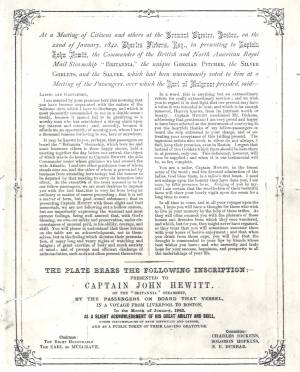
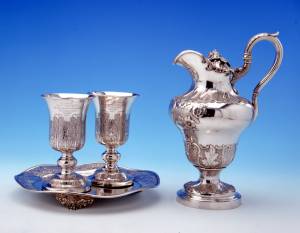
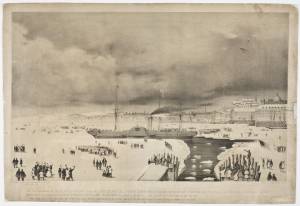

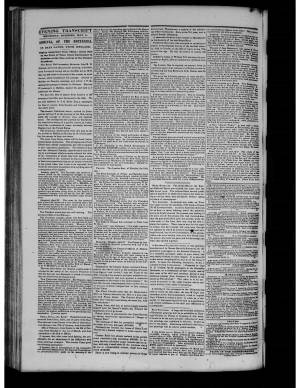

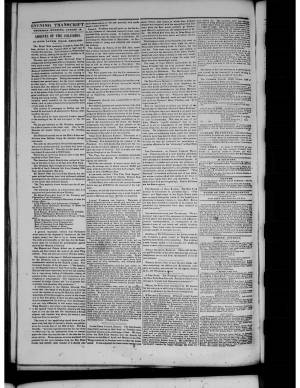
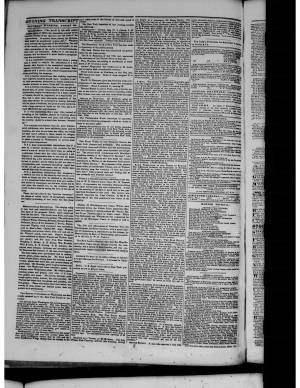
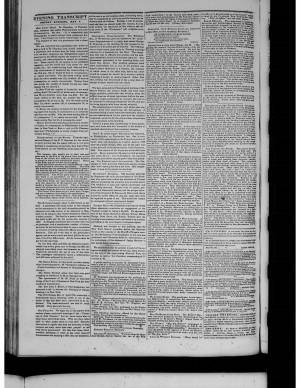
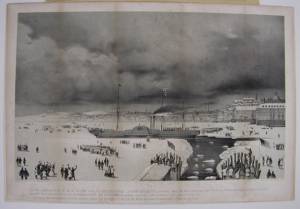
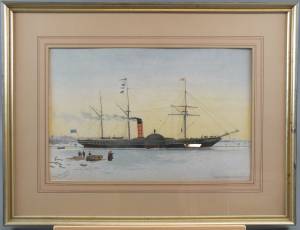
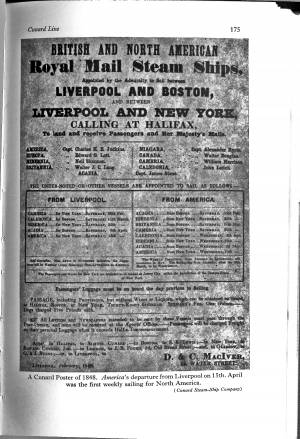
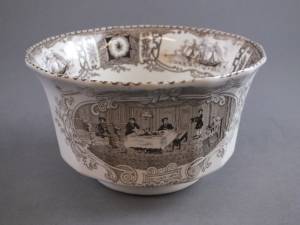

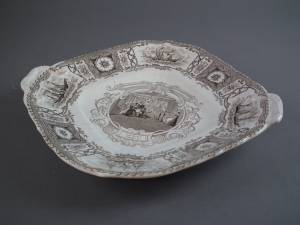
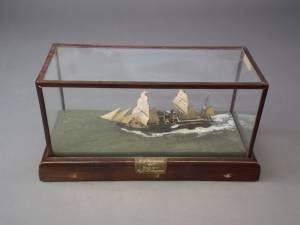
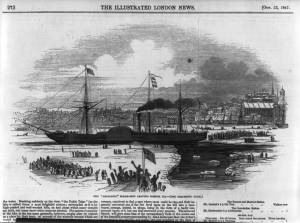
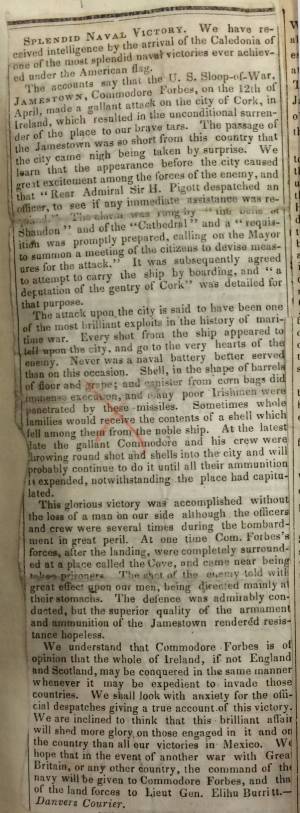
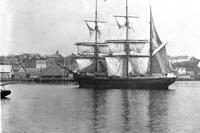

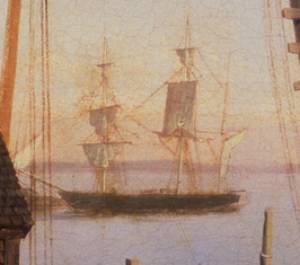


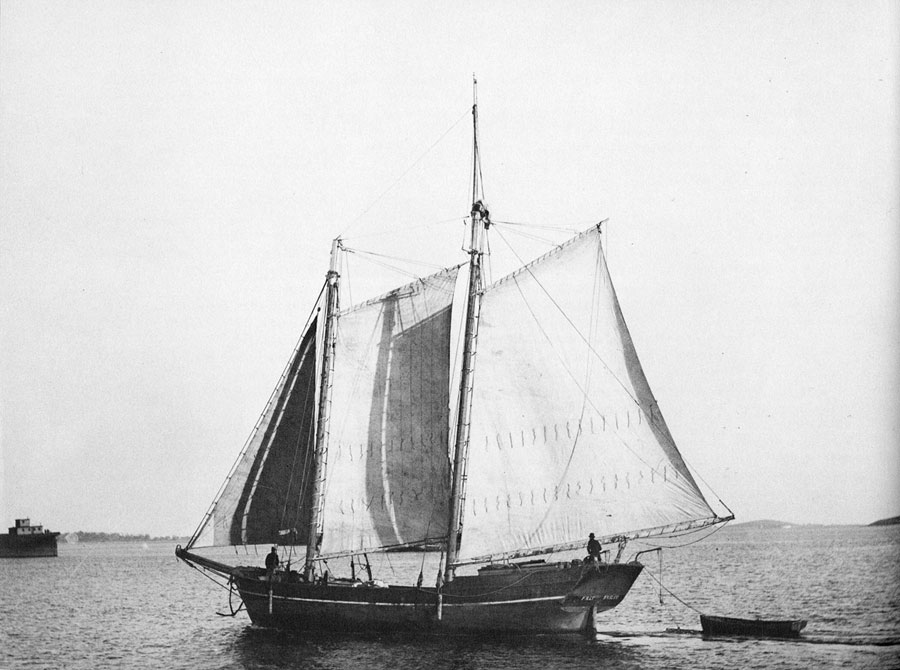
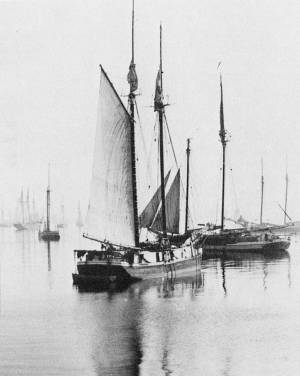


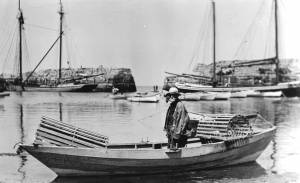

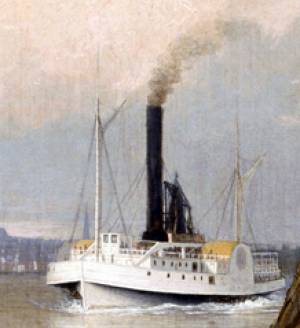

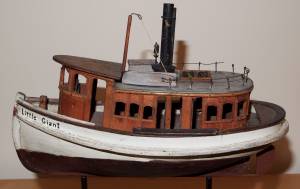
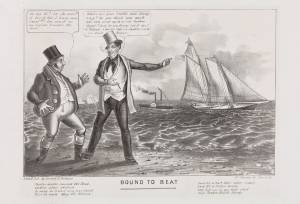

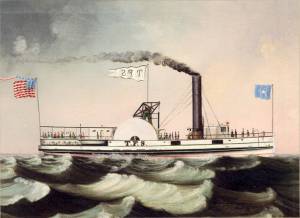

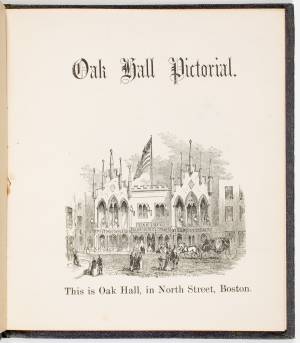
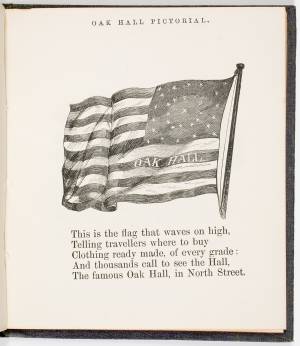



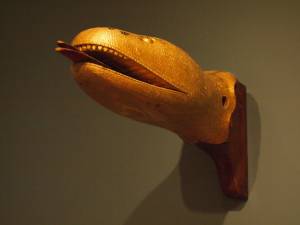
Commentary
This picture has long been thought to depict the arrival of British steamship "Britannia" in Boston Harbor in 1840, however the signal flags displayed by the vessel indicate that although it is part of the same Britannia class as the steamship "Britannia," it is actually a ship named the "Caledonia."
The important event of the arrival of the "Britannia" in 1840 established a strong commercial link with Great Britain, and made Boston the major American port for the transmission of mail and cargo to and from Europe. Steamships were familiar sights to Bostonians by this time, but it was noteworthy to see such an important vessel.
[+] See More